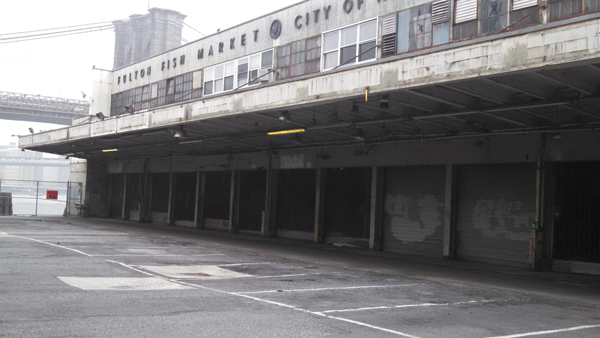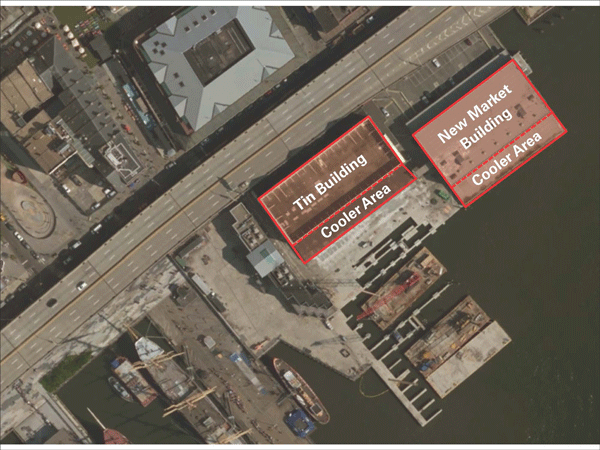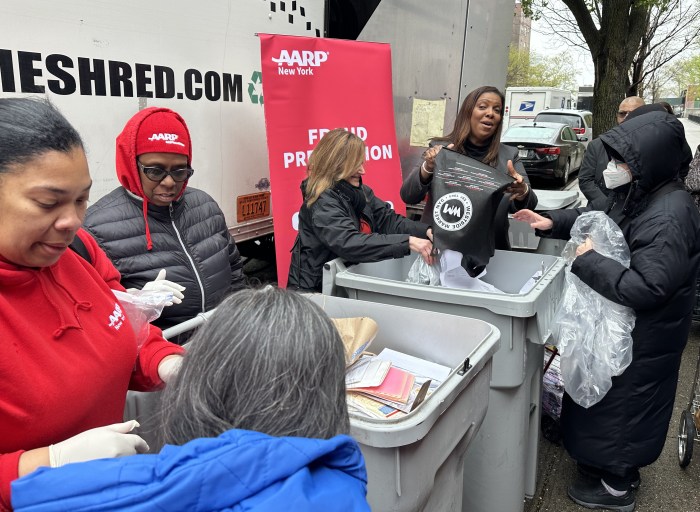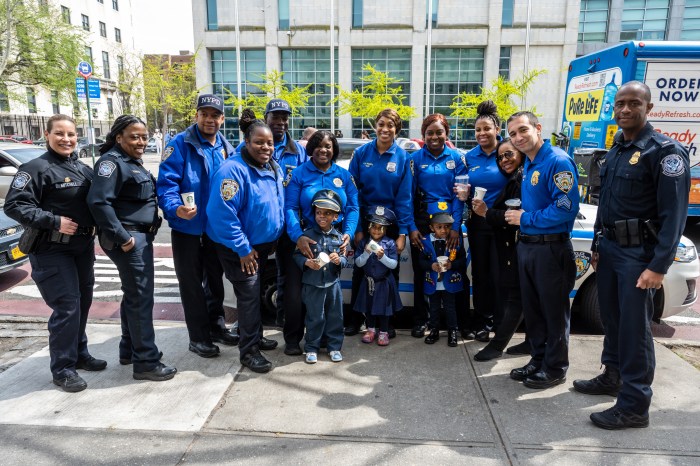
Artist Naima’s Rauam 2005 painting, “Working through a Snowstorm, Fulton Fish Market” shows what she calls the “iconic” New Market Building.
BY JOSH ROGERS | For at least a decade or two, there hasn’t been much reason to hope the South Street Seaport’s New Market Building would be preserved, but the city likely began hammering the final nails in the building’s coffin last week.
“It was just an iconic view with the Brooklyn Bridge in the background and the dawn light,” Seaport artist Naima Rauam, 69, who began her life’s work documenting the area in paintings nearly 50 years ago, said Tuesday. “You’d see this miraculous sunrise after the workers were done. It sparkled in the evening.”
The 1939 building was the last to be constructed for the Fulton Fish Market and its more modern look was at least one reason the city has never landmarked it. Rauam said the prominent “Fulton Fish Market” lettering on the building makes a strong visual tie to the history, particularly since smaller lettering on some of the 19th century buildings have faded long ago.
Plans are to demolish the back “cooler area” of the building in July or August because the city’s Economic Development Corp. has determined it is in danger of collapse.
Internal E.D.C. emails in April concluded a complete demolition was necessary, Crain’s reported last week.

The New Market Building.
In response to Downtown Express questions, Kelly Magee, E.D.C.’s spokesperson, did not deny the accuracy of the reports about the emails, or that officials still anticipate demolishing the city-owned building, but she maintains no final decision will be made until after the first phase.
“The demolition of the cooler area is a first step,” she wrote in an email, and future work could “include full or partial demolition of the Tin and New Market buildings.”
Unlike New Market, the Tin Building next door is in the city’s South Street Seaport Historic District and is slated to be restored under a proposal by the area’s developer, Howard Hughes Corp. The firm has hopes of demolishing New Market to construct a 500-foot residential tower.
Some opponents of the project see the demolition news as a way to jumpstart the Hughes development plan, which remains on hold due in part to local opposition.
“What’s our basis for saying we want something else on the New Market Building if it no longer exists,” Community Board 1’s Paul Hovitz said at a board meeting Tuesday night. “Doesn’t that then pave the way for them to say ‘well it’s not there anymore so let’s put a tower on it.’ ”
The city says the partial demolition has nothing to do with the development plans, and it has reached out to local politicians. E.D.C. officials also took a few members of Board 1 on a private tour Tuesday. The reaction to the message varies.
One person directly involved, speaking on the condition of anonymity, said “You sort of have to take them at their word. Trust? Do we believe them? It’s the Reagan line, ‘trust but verify.’”

Councilmember Margaret Chin’s spokesperson, Sam Spokony, did not want to use the word “concern.”
“We’re following it very closely,” he said.
Everyone agrees that the pier supporting the New Market and Tin, and the buildings themselves are badly in need of repairs which get costlier with time. A 2010 report by E.D.C. estimated it would cost about $10 million to stabilize the New Market and Tin, but the current estimate from Hughes for the pier supporting them is about $75 million.
Some members of C.B. 1 and Save Our Seaport, an advocacy group, say the city has “abrogated their stewardship and responsibility” for the buildings out of neglect, and the city and developer shouldn’t benefit as a result.
Hughes, which declined to comment for this article, argues that the only way to get benefits like a middle school, affordable housing, restoration of the Tin, and better waterfront access — all part of the current proposal — is to accept a revenue-generating tower at New Market, which is designated in state and federal registries, but has no city Landmarks protection.
Although C.B. 1 and preservationists have been fighting for many years to add the New Market to the city’s historic district, the city has always seen it as a development site. Even Bruce Ehrmann, co-chairperson of the board’s Landmarks Committee acknowledged this year the effort was “like beating a dead horse.”
Because of the Tin’s precarious state, Hughes had proposed carefully dismantling it and restoring it close to its original state, so the latest news presumably should not change those plans, although not everyone is sure.
“It seems clear to me that the reason the Landmarks application for the Tin Building is not proceeding is because E.D.C. is intending to demolish both it and the New Market building,” Simeon Bankoff, executive director of the Historic Districts Council, wrote in an email to Downtown Express. “The people making decisions are acting in bad faith with regard to the public process and the historic buildings of the Seaport.”
His group, Community Board 1’s Seaport Committee, Save Our Seaport, and others have recently signed onto a draft letter to Mayor de Blasio criticizing the overall Seaport process for ”an egregious absence of transparency.”
E.D.C. officials did not attend Tuesday night’s Board 1 meeting but the Seaport Committee is expecting the agency to show up to its next meeting, June 16.
For her part, Rauam, the Seaport artist, surprisingly, is not one of the people opposing the proposed demolition of the New Market — whether it’s done by the city or by Hughes someday — even though she kept using the word “iconic” to describe its importance to the fish market, which moved to the Bronx in 2005.
She said she has always seen her role as an observer to chronicle the neighborhood, not to be the change. She’s also OK with moving the Tin a little away from the F.D.R. Drive, which Hughes wants to do so it can be raised for flood protections.
“If it has to come down, it has to come down. So be it,” she said of New Market. “Moving the Tin is fine. None of us ever saw that building because of the awful highway.”

















